This article was co-authored by Ni-Cheng Liang, MD. Dr. Ni-Cheng Liang is a board certified Pulmonologist and the Director of Pulmonary Integrative Medicine at Coastal Pulmonary Associates affiliated with the Scripps Health Network in San Diego, California. She also serves as a Voluntary Assistant Professor of Medicine at the University of California San Diego School of Medicine while volunteering for the UCSD Medical Student-Run Free Clinic for uninsured patients. With over 15 years of experience, Dr. Liang specializes in pulmonary and respiratory medical concerns, mindfulness teaching, physician wellness, and integrative medicine. Dr. Liang received her Doctor of Medicine (MD) from the University of Maryland School of Medicine. Dr. Liang was voted as a San Diego Top Doctor in 2017 and 2019. She was also awarded the 2019 American Lung Association San Diego Lung Health Provider of the Year.
There are 11 references cited in this article, which can be found at the bottom of the page.
wikiHow marks an article as reader-approved once it receives enough positive feedback. This article has 30 testimonials from our readers, earning it our reader-approved status.
This article has been viewed 5,750,889 times.
Nasal mucus is a clear, sticky, liquid that works as a filter to prevent unwanted particles in the air from entering your body through your nose. Mucus is a natural part of your body’s defenses, but sometimes it can be produced in excess. Dealing with excessive mucus can be frustrating and seemingly never ending. The best way to treat excessive mucus from your nasal passages is to determine what is causing it to be produced and treat the underlying problem. Common causes of excessive nasal mucus are allergic reactions, nonallergic rhinitis, infection, and structural abnormalities.
Steps
Easy At-Home Remedies
-
1Use a neti pot or other sinus irrigating device. A neti pot is a device that resembles a small teapot. Used correctly, a neti pot flushes out mucus and trapped irritants, and moisturizes your sinus passages.[1]
- The device works by putting saline or distilled water in one nostril and allowing it to drain out the other, removing unwanted irritants and germs.
- Fill the neti pot with about 4 ounces of saline solution or distilled water and the sterile powder packet that came with the device. Then, lean over a sink, turning your head sideways and hold the spout up to the upper nostril.
- Tip the pot to fill the nostril and let it run out the other nostril. Repeat the procedure using the other nostril.
- This process is called irrigation since you are flushing out the passages with a liquid to get rid of unwanted mucus and irritants that are causing the mucus. Use your neti pot once or twice daily.
- Neti pots provide a moisturizing and soothing effect to the sinuses. A neti pot can be purchased inexpensively over-the-counter. Be sure to clean your neti pot thoroughly after each use.
-
2Apply warm compresses to your face. The warm compresses can help relieve any pain from sinus pressure and help to loosen the mucus and allow it to drain to get it out of your sinuses.[2]
- Wet a small towel or cloth with very warm water. Place the towel on your face where you feel the most pressure.
- In general, cover your eyes, the area just above your eyebrows, nose, and your cheeks just below your eyes.
- Warm the cloth again every few minutes and reapply to continue to relieve the pain and pressure.
Advertisement -
3Sleep with your head elevated. This can help your sinuses to drain through the night and prevent mucus buildup in the nasal passages.[3]
- Get enough rest to help keep your body strong and help to fight off a pending sinus infection from the excessive mucus in your sinuses.
-
4Humidify your living space. Dry air can act as an irritant and cause sinus problems that include runny nose and congestion.[4]
- Humidifiers are available in two primary types, cool mist, and warm mist styles, but there are many variations for each type. If dry sinus passages that lead to discomfort, irritation, and resulting mucus drainage is an ongoing problem for you, consider adding a humidifier to the appliances in your home.
- If you use a humidifier, be sure to clean it regularly to avoid mold growth.[5]
- Other simple ways to provide short-term humidification include safely boiling water on the stove, leave the bathroom door open when showering or running a hot bath, or even drying your clothes indoors.
-
5Use steam. Steam helps to break up mucus in your chest, nose, and throat, allowing you to expel it from your body easier.[6]
- Boil a pot of water and hold your face over the bowl and breathe in the steam for several minutes.
- Cover your head with a towel to concentrate your exposure to the steam.
- Additionally, you can take a hot shower to help break up the mucus.
-
6Drink plenty of fluids. Drinking water or other fluids helps to keep the mucus loose. While you may want to stop the runny or stuffy nose immediately, drinking fluids makes the mucus loose and runny. The fluids can help your body to get rid of the mucus you have so you can get back to normal.[7]
- Drinking warm fluids helps in two ways. You are providing the recommended extra fluid intake, and, also, you will breathe in more moisture since the beverage you are drinking is warm or hot.
- Anything that is warm works fine, such as coffee, hot tea, or even a cup of broth or soup.
-
7Avoid irritants. Exposure to irritants like the smoke of any kind, a sudden change in temperature, or strong chemical odors, can cause your sinuses to create even more mucus. Sometimes the mucus will run down the back of your throat, known as postnasal drip, and sometimes the irritants can cause your lungs to produce mucus, called phlegm. You may feel the need to cough to remove the buildup of the phlegm.[8]
- Quit smoking or vaping if you do either. Try to avoid being exposed to second-hand cigarette or cigar smoke.
- If you know this is a trigger for you, also take care to avoid situations outside that may involve burning yard debris, or stay upwind of the smoke from a bonfire.
- Other pollutants that we breathe in can cause sinus problems as well. Watch for dust, pet dander, yeast, and molds, in your home and workplace. Be sure to change your air filters regularly to limit your exposure to irritants in the air of your home.
- Exhaust fumes, chemicals used in your work, and even smog, can trigger an episode of mucus production caused by something other than an allergen. This is termed nonallergic rhinitis.
-
8Protect your sinuses from sudden temperature changes. If your work requires that you are outside in colder temperatures, it can often contribute to mucus buildup and release when you enter a warmer environment.[9]
- Take steps to keep your face and nasal area warm during the time you are outside in the colder temperatures.
- Use a hat for head protection, and consider wearing one that has facial protection, similar to a ski mask.
-
9Blow your nose. Blow your nose gently and correctly. Some experts suggest that blowing your nose may cause more problems than it helps.[10]
- Blow your nose gently. Clear only one nostril at a time.
- Blowing too hard can cause small openings to develop in your sinus areas. If you have any bacteria or unwanted irritants in your nose, then you may be forcing them further back into your sinuses as you blow your nose.
- Wash your hands thoroughly before and after you blow your nose.[11]
Over-The-Counter Products
-
1Take an antihistamine product. Over-the-counter antihistamines are very helpful with minimizing the sinus problems associated with allergen exposure, or allergic rhinitis.[12]
- Antihistamines work by blocking the reaction caused by exposure to an allergen. The reaction causes the release of histamine, and antihistamines help to minimize the body’s response to exposure to an allergen or irritant.
- Antihistamines are most useful in people that have known allergies. Some are seasonal, and some are year-round risks.
- Seasonal allergic problems are caused by the release of substances from the plants in our environment as they begin to bloom and blossom in the spring and fall. Fall allergies are often caused by ragweed.
- People with year-round allergy problems are allergic to other things that are difficult to avoid in the environment. This can include everything from dust and pet dander to cockroaches and other insects that live in and around our homes.
- Antihistamines help, but for people that have severe seasonal allergies or year-round problems, more intense allergy therapy may be warranted. Talk to your doctor about other options.
-
2Use decongestants. Decongestant products are available as oral doses and nasal sprays. The more common side effects cause by these products include nervousness, dizziness, feeling that your heart rate is increased, slight elevations in blood pressure, and sleep problems. Check with your healthcare provider to see what nasal decongestant they recommend that you take.[13]
- Oral decongestants work by narrowing blood vessels in the nasal passages, helping the swollen tissues to shrink. These products cause more mucus to drain in the short term, but relieve the pressure and improve air flow so you can breathe easier.
- Talk to your doctor about using oral decongestants if you have a heart condition or hypertension.
-
3
-
4Use a medicated nasal spray.[16] Decongestant nasal sprays or drops are also available over-the-counter but should be used with caution. While these products can help to clear sinus passages and relieve the pressure quickly, using them for more than three days results in a rebound effect.[17]
- A rebound effect means that your body adjusts to the medications being used, and the congestion and pressure returns, or is possibly worse than before when you try to stop using them. Limiting their use to no more than three days prevents that rebound effect.
-
5Consider using a nasal corticosteroid. Nasal corticosteroids are available are nasal sprays and help to reduce inflammation in your sinus passages, stopping the runny nose and excessive mucus caused by irritants or allergens.[18] They are used in the chronic treatment of nasal and sinus problems.
- Some are available over-the-counter, and several still require a prescription to obtain. Fluticasone and triamcinolone are available in products that you can purchase without a prescription.
- People that use nasal corticosteroids often experience relief from their sinus problems and excessive mucus within a few days of starting treatment. Be sure to follow the directions on the package.
-
6Use a saline nasal spray. A saline nasal spray helps to clear your nasal passages of mucus and to moisturize your nasal passages. Use the spray as directed, and be patient. The first couple of uses may be helpful, but it will likely take repeated uses to get the full benefit.
- Saline nasal sprays work in a similar manner to that of a neti pot. They provide moisture to damaged and irritated sinus tissues and help to get rid of unwanted allergens and irritants.
- Saline sprays are effective for relieving a runny nose and excessive mucus that is causing nasal congestion and postnasal drip.
Seeking Medical Advice
-
1See your doctor if you have signs of an infection. If you have ongoing problems with nasal mucus and sinus congestion, then it is possible that bacteria can become lodged in your sinuses and develop into a sinus infection.[19]
- Symptoms of a sinus infections include prolonged sinus pressure, congestion, pain, or a headache for more than seven days.
- If you develop a fever, you may have a sinus infection.
-
2Watch for changes in the mucus. If the mucus changes to a greenish or yellowish color instead of clear or develops an odor, then you may have bacteria growing in your sinus passages leading to a sinus infection.
- When your sinuses get blocked with congestion, the mucus, and bacteria that is normally produced gets trapped. If the congestion and pressure are not relieved, the trapped bacteria can lead to a sinus infection.
- You may also get a viral sinus infection if the congestion and pressure were caused by a cold or the flu.
- Antibiotics are ineffective if the infection is due to a virus. If you have a cold or flu virus, treat with zinc, vitamin C, and any medication recommended by your doctor.
-
3Take antibiotics as prescribed. If your doctor determines that you have developed a bacterial sinus infection, antibiotics may be prescribed for you. Be sure you take them exactly as prescribed and for the full duration of the prescription.
- Even if you start to feel better quickly, finish the prescription as prescribed. Not doing so may result in resistive strains of bacteria.[20] It is also beneficial as the bacteria can still be lingering in your sinus passages.
- Be aware that some doctors may prescribe antibiotics before receiving test results that identify the actual cause of infection.[21]
- If the symptoms persist even after you have finished the course of antibiotics, let your doctor know. You may need another course or a different antibiotic.
- Talk to your doctor about allergy testing or other preventive measures if this happens to you frequently.
-
4Seek medical help for persistent problems. Some situations of excessive mucus production seem to go on and on, no matter what treatments you try.[22]
- If you have persistent problems with rhinitis, or continued and excessive mucus production, talk to your doctor.[23]
- You may need to undergo a series of tests to determine if you are allergic to things you come into contact with in your home or workplace.
- Plus, you may have developed a nasal polyp or other structural change in your sinuses that is contributing to your lingering problem.
-
5Ask about structural abnormalities. The most common structural abnormality that causes excessive mucus is the development of nasal polyps.[24]
- Nasal polyps can develop over time. Small polyps most often go unnoticed and cause no problems.
- Larger polyps can block the airflow through your sinus passages, and cause irritation that leads to excessive mucus production.
- Other structural abnormalities are possible, such as deviated septum, and enlarged adenoids, but they do not usually cause excessive production of mucus.
- Injury to the nose or surrounding area can also result in structural abnormalities, and can sometimes have related symptoms like mucus production. Talk to your doctor if you have had a recent injury to your facial area or nose.
Foods and Drinks to Get Rid of Mucus
Expert Q&A
Did you know you can get expert answers for this article?
Unlock expert answers by supporting wikiHow
-
QuestionWhat's a natural way to get rid of mucus?
 Ni-Cheng Liang, MDDr. Ni-Cheng Liang is a board certified Pulmonologist and the Director of Pulmonary Integrative Medicine at Coastal Pulmonary Associates affiliated with the Scripps Health Network in San Diego, California. She also serves as a Voluntary Assistant Professor of Medicine at the University of California San Diego School of Medicine while volunteering for the UCSD Medical Student-Run Free Clinic for uninsured patients. With over 15 years of experience, Dr. Liang specializes in pulmonary and respiratory medical concerns, mindfulness teaching, physician wellness, and integrative medicine. Dr. Liang received her Doctor of Medicine (MD) from the University of Maryland School of Medicine. Dr. Liang was voted as a San Diego Top Doctor in 2017 and 2019. She was also awarded the 2019 American Lung Association San Diego Lung Health Provider of the Year.
Ni-Cheng Liang, MDDr. Ni-Cheng Liang is a board certified Pulmonologist and the Director of Pulmonary Integrative Medicine at Coastal Pulmonary Associates affiliated with the Scripps Health Network in San Diego, California. She also serves as a Voluntary Assistant Professor of Medicine at the University of California San Diego School of Medicine while volunteering for the UCSD Medical Student-Run Free Clinic for uninsured patients. With over 15 years of experience, Dr. Liang specializes in pulmonary and respiratory medical concerns, mindfulness teaching, physician wellness, and integrative medicine. Dr. Liang received her Doctor of Medicine (MD) from the University of Maryland School of Medicine. Dr. Liang was voted as a San Diego Top Doctor in 2017 and 2019. She was also awarded the 2019 American Lung Association San Diego Lung Health Provider of the Year.
Board Certified Pulmonologist
-
QuestionWhen I cough to disperse the mucus from chest congestion, it hurts my ribs slightly. Is this normal?
 Chris M. Matsko, MDDr. Chris M. Matsko is a retired physician based in Pittsburgh, Pennsylvania. With over 25 years of medical research experience, Dr. Matsko was awarded the Pittsburgh Cornell University Leadership Award for Excellence. He holds a BS in Nutritional Science from Cornell University and an MD from the Temple University School of Medicine in 2007. Dr. Matsko earned a Research Writing Certification from the American Medical Writers Association (AMWA) in 2016 and a Medical Writing & Editing Certification from the University of Chicago in 2017.
Chris M. Matsko, MDDr. Chris M. Matsko is a retired physician based in Pittsburgh, Pennsylvania. With over 25 years of medical research experience, Dr. Matsko was awarded the Pittsburgh Cornell University Leadership Award for Excellence. He holds a BS in Nutritional Science from Cornell University and an MD from the Temple University School of Medicine in 2007. Dr. Matsko earned a Research Writing Certification from the American Medical Writers Association (AMWA) in 2016 and a Medical Writing & Editing Certification from the University of Chicago in 2017.
Family Medicine Physician
-
QuestionIs it bad to swallow mucus if you have C.O.P.D.?
 Chris M. Matsko, MDDr. Chris M. Matsko is a retired physician based in Pittsburgh, Pennsylvania. With over 25 years of medical research experience, Dr. Matsko was awarded the Pittsburgh Cornell University Leadership Award for Excellence. He holds a BS in Nutritional Science from Cornell University and an MD from the Temple University School of Medicine in 2007. Dr. Matsko earned a Research Writing Certification from the American Medical Writers Association (AMWA) in 2016 and a Medical Writing & Editing Certification from the University of Chicago in 2017.
Chris M. Matsko, MDDr. Chris M. Matsko is a retired physician based in Pittsburgh, Pennsylvania. With over 25 years of medical research experience, Dr. Matsko was awarded the Pittsburgh Cornell University Leadership Award for Excellence. He holds a BS in Nutritional Science from Cornell University and an MD from the Temple University School of Medicine in 2007. Dr. Matsko earned a Research Writing Certification from the American Medical Writers Association (AMWA) in 2016 and a Medical Writing & Editing Certification from the University of Chicago in 2017.
Family Medicine Physician
References
- ↑ http://www.health.com/health/gallery/0,,20466430,00.html
- ↑ http://www.mayoclinic.org/diseases-conditions/acute-sinusitis/basics/definition/con-20020609
- ↑ http://www.mayoclinic.org/diseases-conditions/acute-sinusitis/basics/definition/con-20020609
- ↑ http://www.mayoclinic.org/symptoms/runny-nose/basics/definition/sym-20050640
- ↑ Ni-Cheng Liang, MD. Board Certified Pulmonologist. Expert Interview. 23 October 2020.
- ↑ http://www.minahealth.com/how_do_i_get_rid_of_phlegm.htm
- ↑ http://www.mayoclinic.org/symptoms/runny-nose/basics/definition/sym-20050640
- ↑ http://www.mayoclinic.org/symptoms/runny-nose/basics/definition/sym-20050640
- ↑ http://www.mayoclinic.org/symptoms/runny-nose/basics/definition/sym-20050640
- ↑ http://www.wcvb.com/health/dont-blow-your-nose-too-hard/31883388
- ↑ Ni-Cheng Liang, MD. Board Certified Pulmonologist. Expert Interview. 23 October 2020.
- ↑ http://www.mayoclinic.org/diseases-conditions/hay-fever/basics/definition/con-20020827
- ↑ Ni-Cheng Liang, MD. Board Certified Pulmonologist. Expert Interview. 23 October 2020.
- ↑ Ni-Cheng Liang, MD. Board Certified Pulmonologist. Expert Interview. 23 October 2020.
- ↑ Ni-Cheng Liang, MD. Board Certified Pulmonologist. Expert Interview. 23 October 2020.
- ↑ Ni-Cheng Liang, MD. Board Certified Pulmonologist. Expert Interview. 23 October 2020.
- ↑ http://familydoctor.org/familydoctor/en/drugs-procedures-devices/over-the-counter/decongestants-otc-relief-for-congestion.html
- ↑ http://www.mayoclinic.org/diseases-conditions/hay-fever/basics/definition/con-20020827
- ↑ http://www.mayoclinic.org/diseases-conditions/acute-sinusitis/basics/definition/con-20020609
- ↑ http://www.mayoclinic.org/healthy-lifestyle/consumer-health/in-depth/antibiotics/art-20045720
- ↑ http://www.mayoclinic.org/healthy-lifestyle/consumer-health/in-depth/antibiotics/art-20045720
- ↑ http://www.mayoclinic.org/diseases-conditions/hay-fever/basics/definition/con-20020827
- ↑ Ni-Cheng Liang, MD. Board Certified Pulmonologist. Expert Interview. 23 October 2020.
- ↑ http://www.mayoclinic.org/diseases-conditions/nonallergic-rhinitis/basics/definition/con-20026910
About This Article
To get rid of mucus, try holding a warm compress against your face, which will help break up the mucus so it clears out of your sinuses. You can also boil water and hold your face over it for a few minutes to let the steam loosen up the mucus. Alternatively, drink some tea or another warm beverage, which can help clear up your congestion. Or, you can flush the mucus out of your sinuses using a neti pot and some saline solution. Keep reading the article for more advice from our Physician co-author, like how to get rid of mucus using over-the-counter medicine!
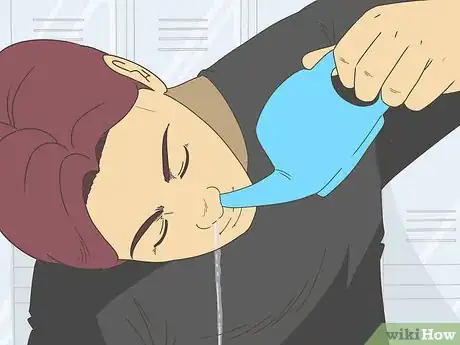
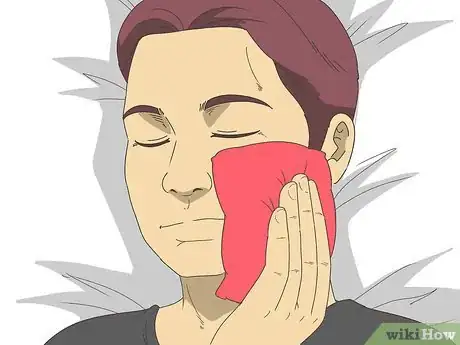
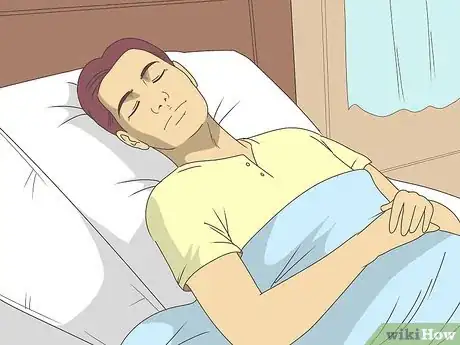
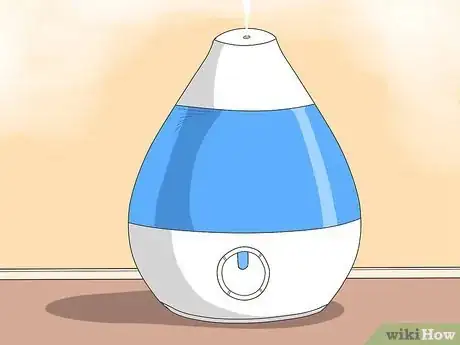

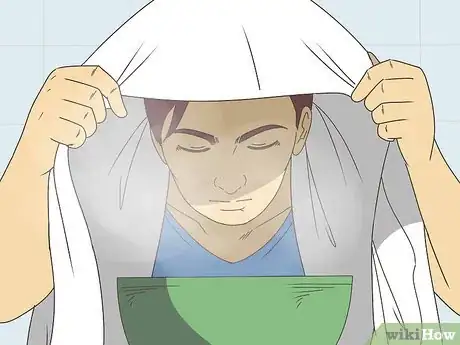

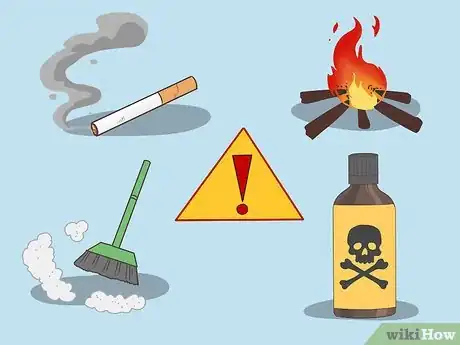

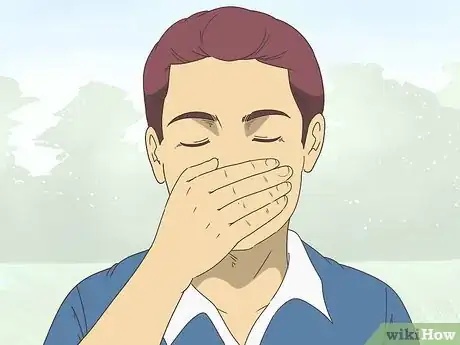
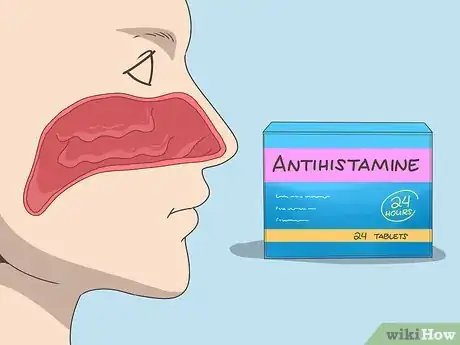
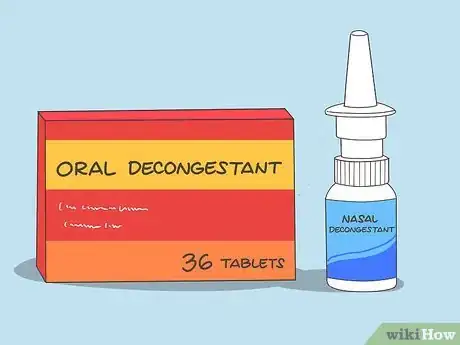
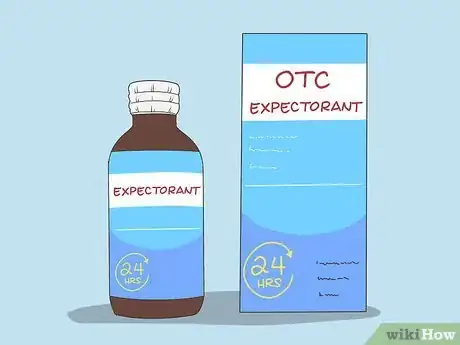

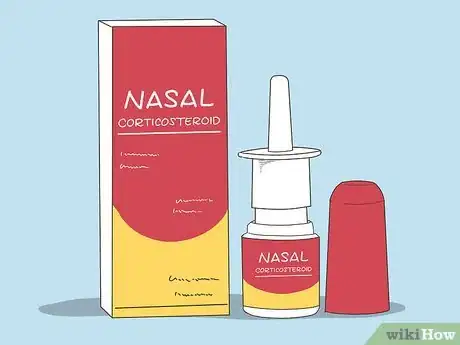
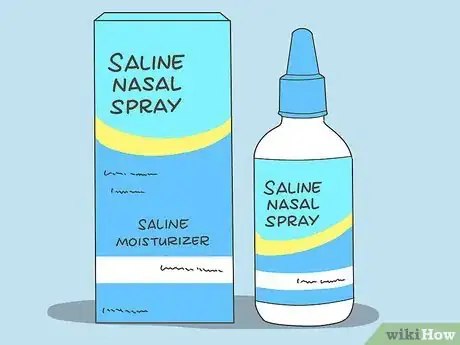
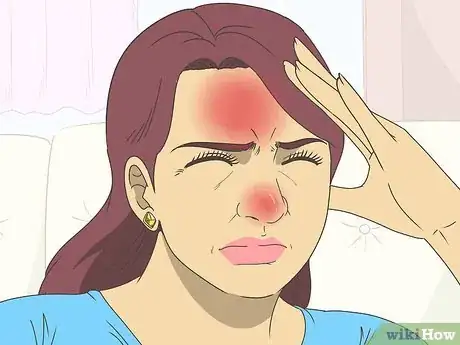
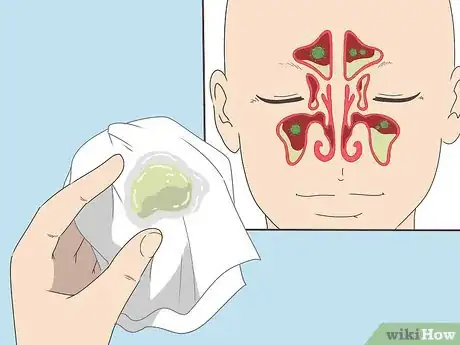
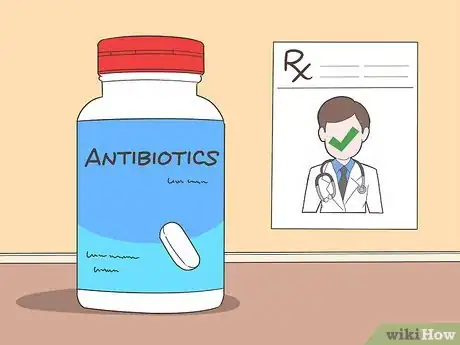
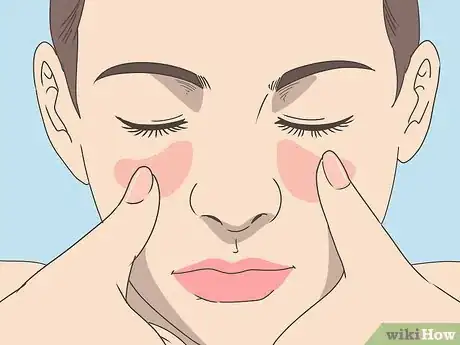
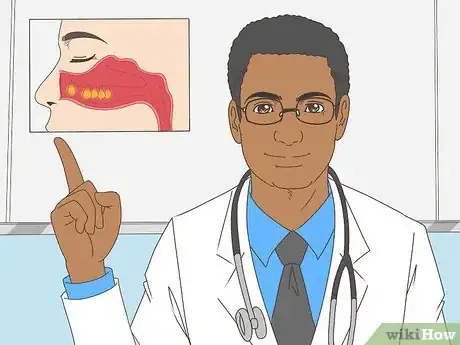
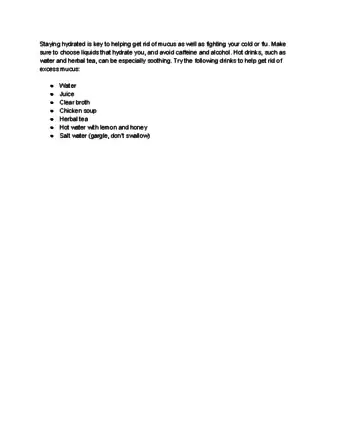
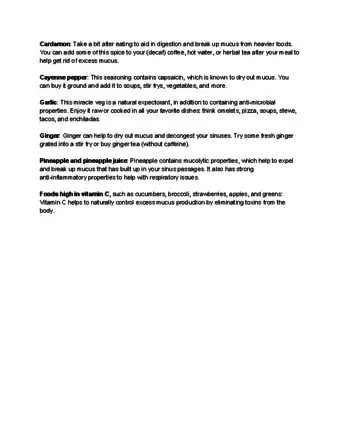


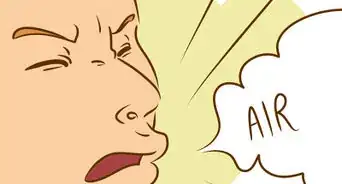
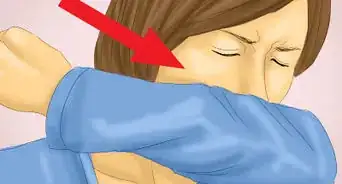
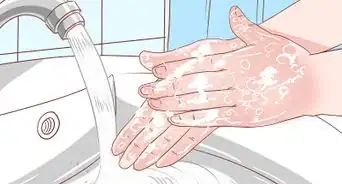
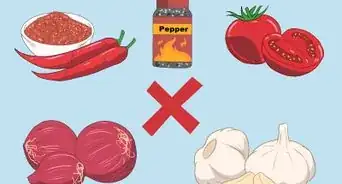

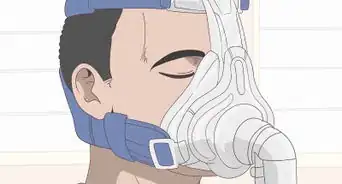

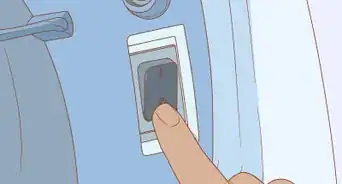
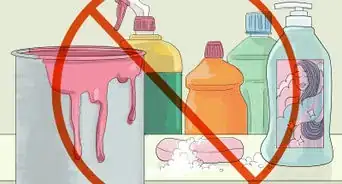
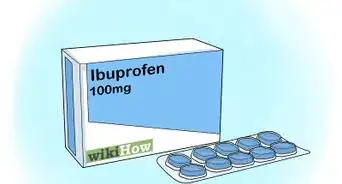
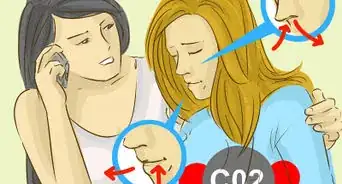











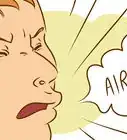
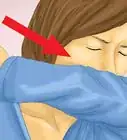



































Medical Disclaimer
The content of this article is not intended to be a substitute for professional medical advice, examination, diagnosis, or treatment. You should always contact your doctor or other qualified healthcare professional before starting, changing, or stopping any kind of health treatment.
Read More...